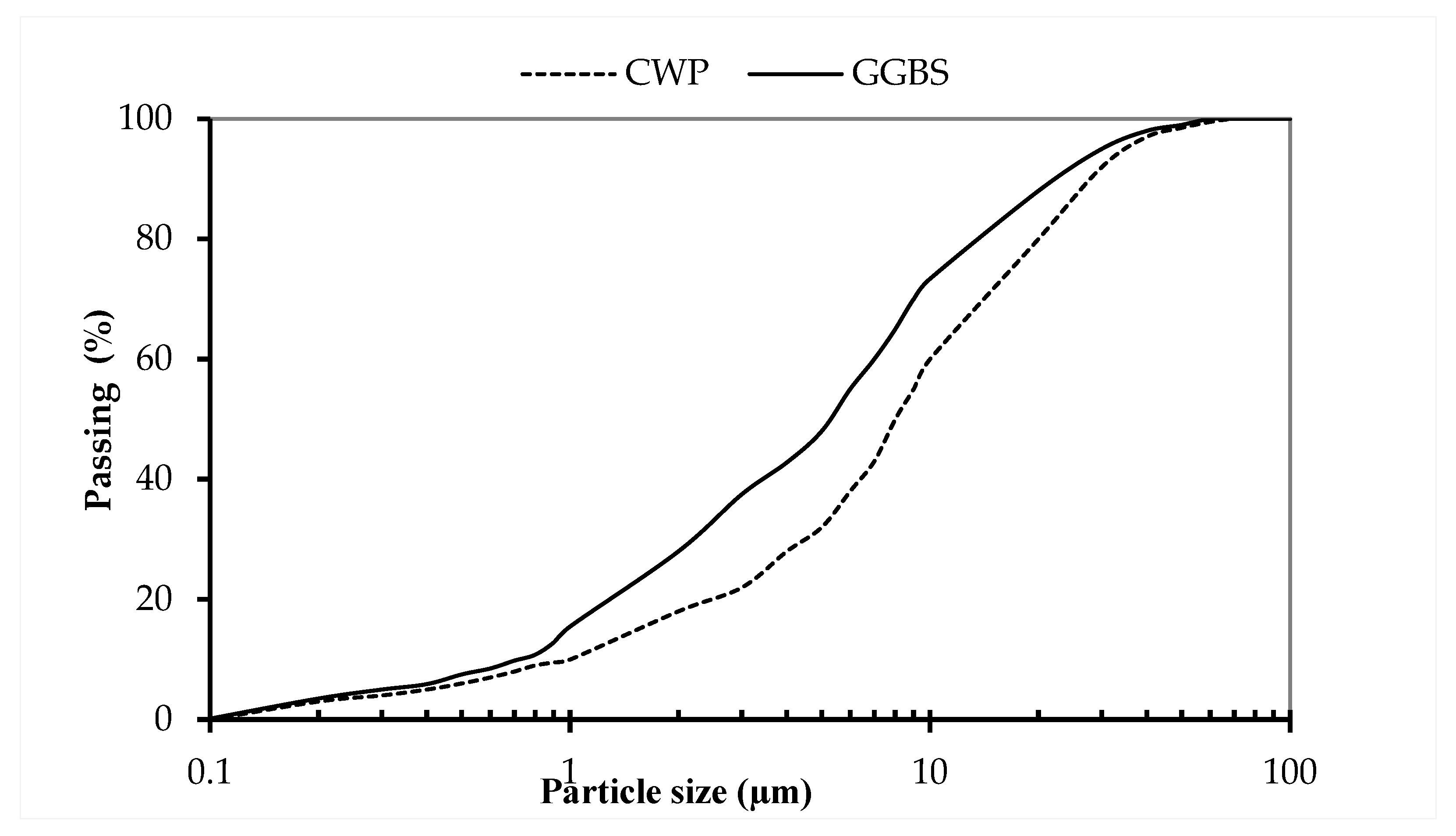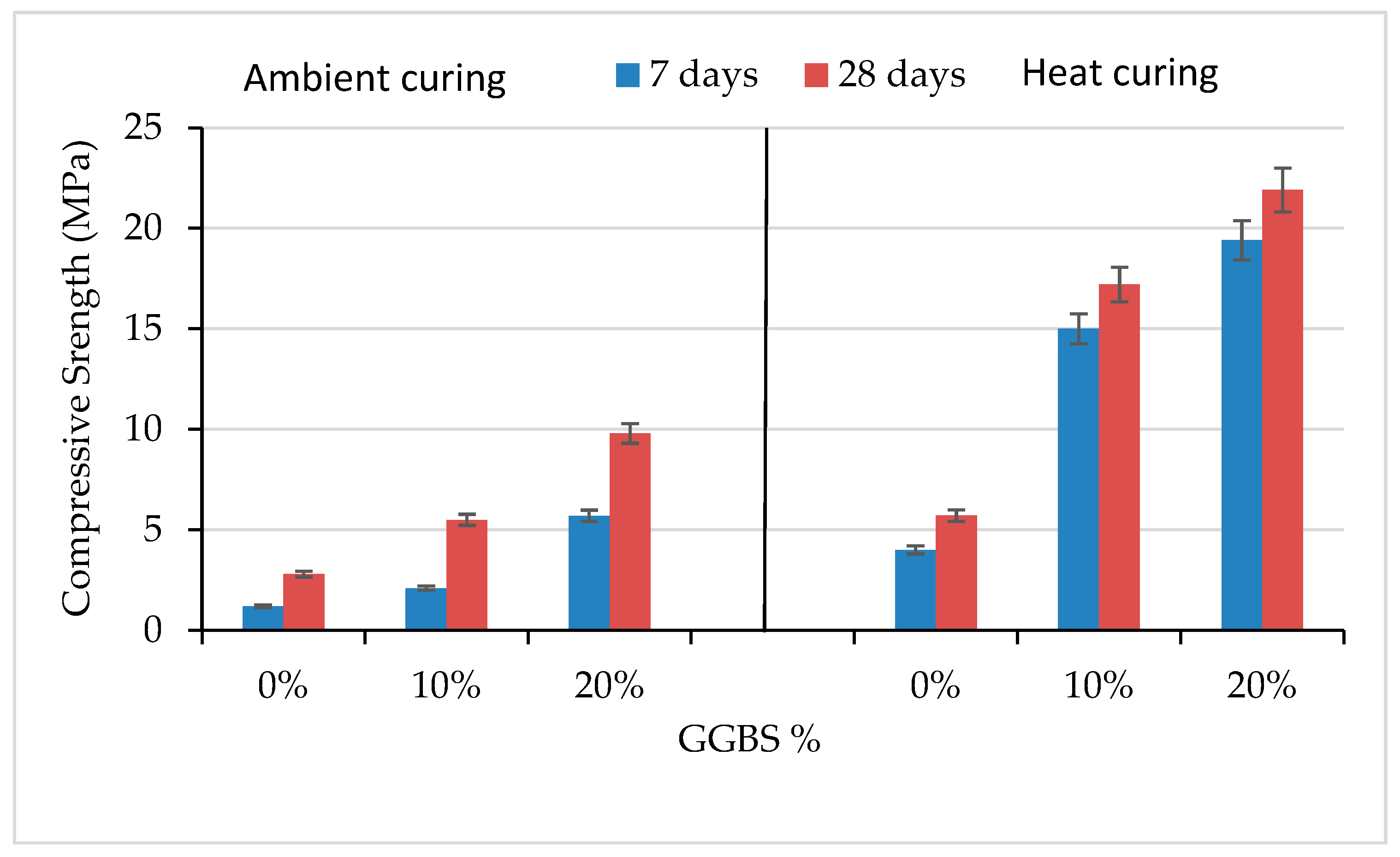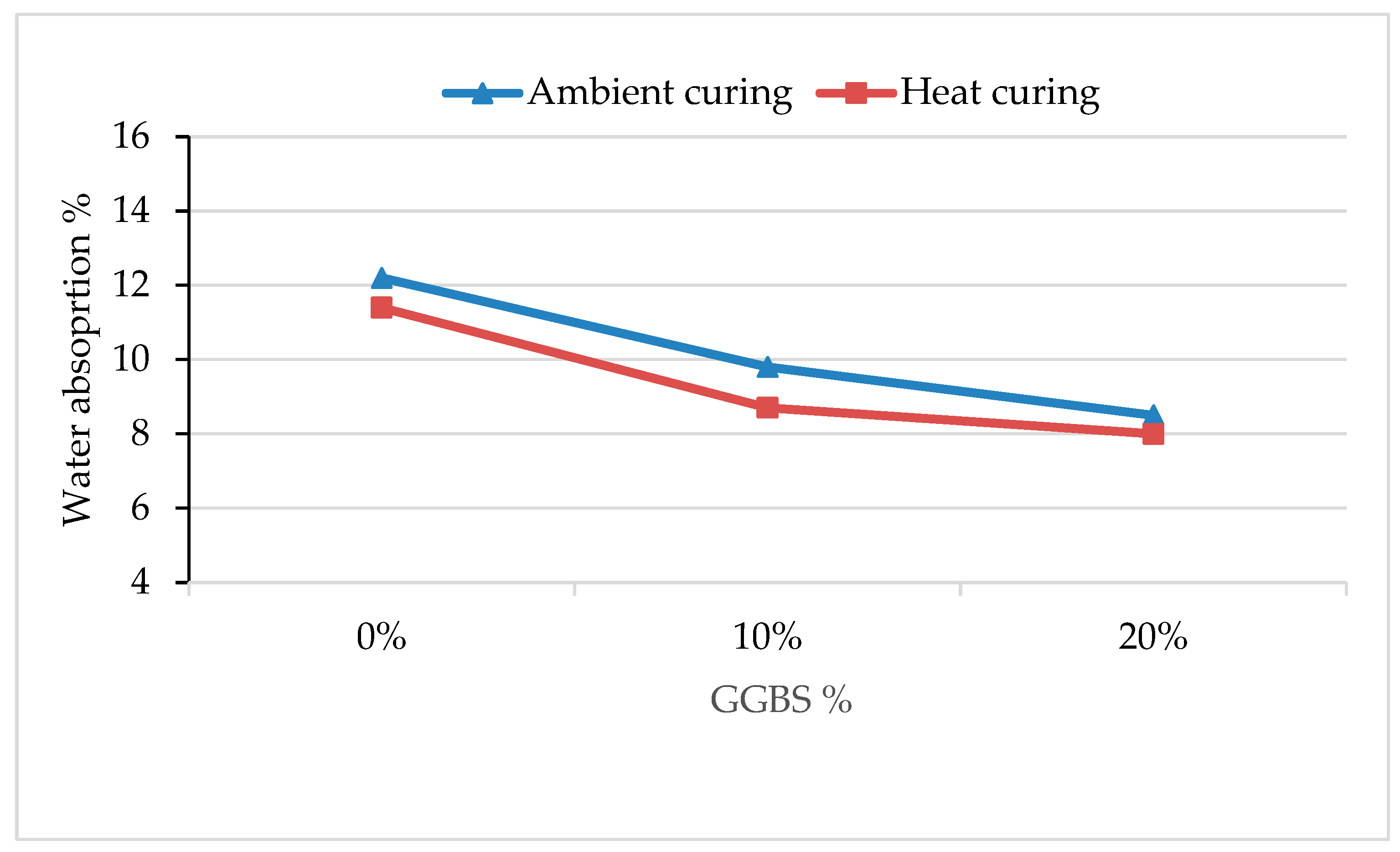Strength and Durability Properties of Geopolymer Mortar Made with Concrete Waste Powder †
Abstract
:1. Introduction
2. Experimental Program
2.1. Material
2.2. Alkaline Solution
2.3. Mix Proportion and Mixing of Geopolymer Mortar
3. Test Methods
3.1. Compressive Strength
3.2. Water Absorption and Porosity
4. Results and Discussion
4.1. Compressive Strength
4.1.1. Effect of GGBS Replacement on Compressive Strength
4.1.2. Effect of Curing on Compressive Strength
4.2. Water Absorption and Porosity
4.2.1. Effect on Water Absorption
4.2.2. Effect on Porosity
5. Conclusions
- ➢
- The CWP alone is capable of providing a satisfactory compressive strength in geopolymer mortar; however, along with GGBS its compressive strength is increased in ambient conditions and becomes enhanced in heat-curing conditions. By including GGBS, compressive strength can be gained at an early stage of curing.
- ➢
- The size of the GGBS particle is comparatively smaller than the CWP grain and works advantageously in filling the void when substituted with CWP, resulting in a decrease in porosity and water absorption. In this study, both porosity and water absorption decreased by up to 20% of the replacement level.
- ➢
- Heat-cured geopolymer mortar is better than ambient-cured mortar as it results in more compressive strength for the same proportion and is even more durable when checked in terms of water absorption and porosity. Heat curing delivers somewhat less water absorption and slightly less porosity, which makes it more durable to the atmosphere.
Author Contributions
Funding
Institutional Review Board Statement
Informed Consent Statement
Data Availability Statement
Acknowledgments
Conflicts of Interest
References
- Sedira, N.; Castro-Gomes, J.; Kastiukas, G.; Zhou, X.; Vargas, A. A review on mineral waste for chemical-activated binders: Mineralogical and chemical characteristics. Min. Sci. 2017, 24, 29–58. [Google Scholar] [CrossRef]
- Duxson, P.; Provis, J.L.; Lukey, G.C.; van Deventer, J.S.J. The role of inorganic polymer technology in the development of “green concrete”. Cem. Concr. Res. 2007, 37, 1590–1597. [Google Scholar] [CrossRef]
- Liew, Y.M.; Heah, C.Y.; Mohd Mustafa, A.B.; Kamarudin, H. Structure and properties of clay-based geopolymer cements: A review. Prog. Mater. Sci. 2016, 83, 595–629. [Google Scholar] [CrossRef]
- Davidovits, J. Geopolymer Cement; Geopolymer Institute: Saint-Quentin, France, 2013. [Google Scholar]
- Diaz, E.I.; Allouche, E.N.; Eklund, S. Factors affecting the suitability of fly ash as source material for geopolymers. Fuel 2010, 89, 992–996. [Google Scholar] [CrossRef]
- Das, S.; Singh, P.; Negi, V.S. Strength and durability properties of polypropylene fiber reinforced, recycled coarse aggregate concrete. Indian Concr. J. 2018, 92, 62–69. [Google Scholar]
- Rao, A.; Jha, K.N.; Misra, S. Use of aggregates from recycled construction and demolition waste in concrete. Resour. Conserv. Recycl. 2007, 50, 71–81. [Google Scholar] [CrossRef]
- Sharma, A.; Singh, P.; Kapoor, K. Utilization of recycled fine powder as an activator in fly ash based geopolymer mortar. Constr. Build. Mater. 2022, 323, 126581. [Google Scholar] [CrossRef]
- Ahmari, S.; Ren, X.; Toufigh, V.; Zhang, L. Production of geopolymeric binder from blended waste concrete powder and fly ash. Constr. Build. Mater. 2012, 35, 718–729. [Google Scholar] [CrossRef]
- Sun, Z.; Liu, F.; Tong, T.; Qi, C.; Yu, Q. Hydration of Concrete Containing Hybrid Recycled Demolition Powders. J. Mater. Civ. Eng. 2017, 29, 04017037. [Google Scholar] [CrossRef]
- Ren, P.; Li, B.; Yu, J.-G.; Ling, T.-C. Utilization of recycled concrete fines and powders to produce alkali activated slag concrete blocks. J. Clean. Prod. 2020, 267, 122115. [Google Scholar] [CrossRef]
- Nagajothi, S.; Elavenil, S. Effect of GGBS Addition on Reactivity and Microstructure Properties of Ambient Cured Fly Ash Based Geopolymer Concrete. Silicon 2020, 13, 507–516. [Google Scholar] [CrossRef]
- IS 16714: 2018; Indian Standard-Ground Granulated Blast Furnace Slag for Use in Cement, Mortar and Concrete-Specification. Bureau of Indian Standards: New Delhi, India, 2018.
- IS:383-2016; Indian Standard Coarse and Fine Aggregate for Concrete-Specification. Bureau of Indian Standards: New Delhi, India, 2016; pp. 1–21.
- IS 4031-6; Methods of Physical Tests for Hydraulic Cement, Part 6: Determination of Compressive Strength of Hydraulic Cement (Other than Masonry Cement). Bureau of Indian Standards: New Delhi, India, 1988.
- Kurzekar, A.S.; Fating, P.; Mishra, B. An Investigation on Geopolymer Concrete: A Review. Int. J. Disaster Recovery Bus. Contin. 2021, 12, 668–673. [Google Scholar]
- Aggregates, C. Standard Test Method for Density, Absorption, and Voids in Hardened Concrete; ASTM International: West Conshohocken, PA, USA, 2015; Volume 1, pp. 12–14. [Google Scholar]
- Lecomte, I.; Henrist, C.; Liégeois, M.; Maseri, F.; Rulmont, A.; Cloots, R. (Micro)-structural comparison between geopolymers, alkali-activated slag cement and Portland cement. J. Eur. Ceram. Soc. 2006, 26, 3789–3797. [Google Scholar] [CrossRef]
- Rovnaník, P. Effect of curing temperature on the development of hard structure of metakaolin-based geopolymer. Constr. Build. Mater. 2010, 24, 1176–1183. [Google Scholar] [CrossRef]
- Sajan, P.; Jiang, T.; Lau, C.; Tan, G.; Ng, K. Combined effect of curing temperature, curing period and alkaline concentration on the mechanical properties of fly ash-based geopolymer. Clean. Mater. 2021, 1, 100002. [Google Scholar] [CrossRef]
- Horsakulthai, V. Effect of recycled concrete powder on strength, electrical resistivity, and water absorption of self-compacting mortars. Case Stud. Constr. Mater. 2021, 15, e00725. [Google Scholar] [CrossRef]





| Properties | CWP | GGBS |
|---|---|---|
| Fineness, cm2/gm | 3500 | 3900 |
| Specific gravity | 2.5 | 2.85 |
| SiO2 | 58% | 33.1% |
| Al2O3 | 11% | 18.2% |
| Fe2O3 | 2% | 0.31% |
| CaO | 15% | 35.3% |
| MgO | - | 7.6% |
| Loss of ignition | - | 0.26 |
| Properties | SH | SS |
|---|---|---|
| Molecular formula | NaOH | Na2SiO3 |
| Colour | White | White |
| pH | 13–14 | 13–14 |
| Na2O content (%) | - | 9 |
| SiO2 content (%) | - | 27.2 |
| H2O content (%) | - | 63.8 |
| Mix Notations | Mix Description | CWP | GGBS | NFA | SS | SH |
|---|---|---|---|---|---|---|
| C100 | 100% CWP | 500 | - | 1500 | 150 | 75 |
| C90G10 | 90% CWP + 10% GGBS | 450 | 57 | 1500 | 150 | 75 |
| C80G20 | 80% CWP + 20% GGBS | 400 | 114 | 1500 | 150 | 75 |
Disclaimer/Publisher’s Note: The statements, opinions and data contained in all publications are solely those of the individual author(s) and contributor(s) and not of MDPI and/or the editor(s). MDPI and/or the editor(s) disclaim responsibility for any injury to people or property resulting from any ideas, methods, instructions or products referred to in the content. |
© 2023 by the authors. Licensee MDPI, Basel, Switzerland. This article is an open access article distributed under the terms and conditions of the Creative Commons Attribution (CC BY) license (https://creativecommons.org/licenses/by/4.0/).
Share and Cite
Saini, P.; Singh, P.; Kapoor, K. Strength and Durability Properties of Geopolymer Mortar Made with Concrete Waste Powder. Eng. Proc. 2023, 59, 129. https://doi.org/10.3390/engproc2023059129
Saini P, Singh P, Kapoor K. Strength and Durability Properties of Geopolymer Mortar Made with Concrete Waste Powder. Engineering Proceedings. 2023; 59(1):129. https://doi.org/10.3390/engproc2023059129
Chicago/Turabian StyleSaini, Pankaj, Paramveer Singh, and Kanish Kapoor. 2023. "Strength and Durability Properties of Geopolymer Mortar Made with Concrete Waste Powder" Engineering Proceedings 59, no. 1: 129. https://doi.org/10.3390/engproc2023059129






